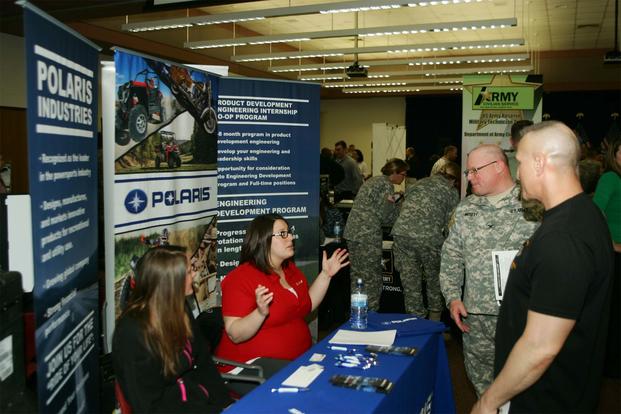Dire early numbers on jobs from the Labor Department for March and even more alarming figures from the states point to the obvious in the age of coronavirus: historic spikes in unemployment rates that could hit the post-9/11 generation of veterans especially hard.
"We know it's coming; everybody does," Thomas Porter, executive vice president for government affairs at Iraq and Afghanistan Veterans of America (IAVA), said of the expected jump in unemployment rates when the Bureau of Labor Statistics releases the final numbers for March in the first week of April.
"I've seen the reports from employment agencies across the country getting a huge spike in applicants" for unemployment benefits, said Porter, a Navy veteran of Afghanistan. "We expect a huge uptick in demand for services."
His concerns were borne out by the BLS report for the second week in March, which showed that initial claims for state unemployment benefits, a key indicator of layoffs, climbed by 70,000 to 281,000.
Related: The Military's Coronavirus Response
The increase of more than 30% in initial claims from the previous week was "clearly attributable to impacts from the COVID-19 virus," the report said. "A number of states specifically cited COVID-19 related layoffs, while many states reported increased layoffs in service-related industries broadly and in the accommodation and food services industries specifically."
Based on the BLS numbers, investment bank Goldman Sachs and Bank of America Merrill Lynch projected that initial claims for unemployment could be in the range of 2 to 3 million when BLS issues another weekly claims report Thursday.
The surge in claims threatened to overwhelm the ability of state offices to deal with them. Long waits to get through to state offices were reported nationwide, and New York, Oregon and New Jersey reported website crashes.
Colorado reported that 11,000 claims were filed March 16-17, compared to the usual weekly average of 400.
Louisiana reported that 30,000 new claims for unemployment assistance were filed from March 16-19, up from 1,700 in the previous week.
The blizzard of rules and regulations on who qualifies for unemployment insurance, and when and how to apply, vary from state to state and can complicate the process for a recently laid-off worker seeking to navigate the systems.
Virginia's Employment Commission advised, "If you are a worker who has been totally or partially separated from your job due to coronavirus, please note that no claim for unemployment insurance may be filed or processed until an actual lay off from employment has occurred, or until there has been an actual reduction in hours."
Washington state's Employment Security Department advised, "If you are following guidance issued by a medical professional or public health official to isolate or quarantine yourself as a result of exposure to COVID-19, and you are not receiving paid sick leave from your employer, you may be eligible to receive unemployment benefits."
However, the Virginia commission said, "Eligibility decisions are made on a case-by-case basis."
No Signs of Pandemic Slowing Down
The coronavirus pandemic that has sent shock waves through world economies showed no signs of abating as it progressed exponentially in the U.S. and elsewhere.
By mid-morning Sunday, the number of confirmed cases in the U.S. had passed 27,000 -- up 3,000 from the day before -- and the number of deaths approached 350, according to the Johns Hopkins Coronavirus Resource Center and other estimates.
Worldwide, there were more than 318,000 cases and more than 13,600 deaths. Italy was the hardest hit, with more than 53,500 cases and more than 4,800 deaths.
As a result, the near-historic lows in unemployment rates for veterans and the general population recorded in 2019 are expected to come to an abrupt end when BLS reports the figures in the first week of April.
In its last monthly report before the impact from coronavirus could be gauged, BLS said that the economy had added 273,000 jobs in February.
The overall unemployment rate was little changed and stood at 3.5% in February, a tick below the 3.6% in January, to remain in the range of a 50-year low.
The jobless rate for all veterans was 3.6% in February, compared to 3.5% in January and 2.7% in February 2019, the BLS report said.
As is usually the case, the rates for post-9/11 veterans were higher. The unemployment rate in February for post-9/11 veterans was 4.5%, compared to 4.4% in January and 3.4% in February 2019, BLS said.
There have been numerous reports, surveys and academic papers on joblessness among those who served since the Sept. 11, 2001, terror attacks, but the BLS, in separate report last week on the employment situation for veterans, noted the high disability rate for post-9/11 veterans, referred to as "Gulf War II-era" veterans by the bureau.
"In August 2019, 41% of Gulf War-era II veterans had a service-connected disability, compared with 25% percent of all veterans," the report said.
-- Richard Sisk can be reached at Richard.Sisk@Military.com.
Read more: American Woman Rescued in Secretive Military Op, Trump Says














